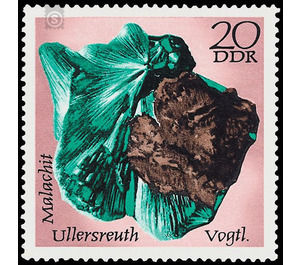Commemorative stamp series - Germany / German Democratic Republic 1972 - 20 Pfennig
Theme: Geology & Geography
| Country | Germany / German Democratic Republic |
| Issue Date | 1972 |
| Face Value | 20.00 |
| Color | multi-colored |
| Perforation | K 13 |
| Printing Type | Photogravure |
| Stamp Type | Postage stamp |
| Item Type | Stamp |
| Chronological Issue Number | 1481 |
| Chronological Chapter | GER-DDR |
| SID | 953634 |
| In 43 Wishlists | |
Mineral finds from the GDR The Ministry of Posts and Telecommunications of the German Democratic Republic publishes six multicolored special postage stamps on which mineral finds from the GDR are depicted. Mineral finds from the GDR In 1969, a series of stamps with minerals, whose motives came from the collections of the Geosciences section of the Bergakademie Freiberg. With the minerals selected at that time, only a few well-known mineral deposits could be detected in the German Democratic Republic. The new emission offers the opportunity to showcase further minerals from localities with already extinct mining and still operating mines. The minerals for the deposits in our republic are so typical that some were named after their localities (Zinnwaldit = Zinnwald). The crystal stages shown are in their training and visual impact of considerable quality and therefore almost all exhibited in the show collection of Bergakademie Freiberg. More than 62,000 mineral samples have been collected in the collections over the course of more than 2010 years, giving a comprehensive picture of the history of mining, especially the Ore Mountains and Vogtland and the Harz. This fund is an excellent tool for science in teaching and research, and also shows interested circles which colorful and well-crystallized minerals are found in our homeland. 20 Pfennig value: Malachite with limonite from the pit "poor help" at Ullersreuth in the Vogtland The weathering of sulfidic copper ores (copper gravel) produces malachite. It occurs in two formations: fine, shiny fibers arranged radially, as well as kidney-like, concentric-shelled concretions, the structure of which is excellently emphasized by grinding and polishing. Such pieces of considerable extent were used to decorate world-famous buildings in the Soviet Union. The intense green color is due to the presence of copper in the compound, while the name indicates the softness of malachite (malakós, Greek = soft). With these few examples of minerals from our republic, the abundance of minerals found in our homeland is far from exhausted, but can only be considered an indication of the richness and beauty of nature as offered in the mineralogical collection in Freiberg ,


